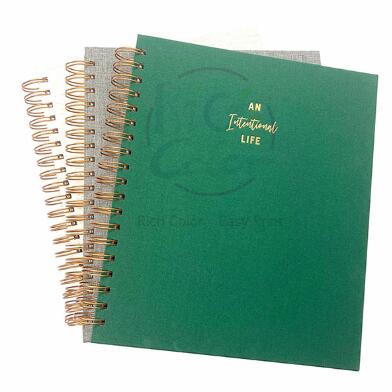Sustainability Spotlight: Cloth vs. Leather vs. Paper in Daily Planners
2024-12-25
Sustainability has become a vital consideration for consumers looking to minimize their ecological footprint. Daily planners are no exception. This blog dives into the sustainability of cloth, leather, and paper materials to determine which offers the most eco-friendly solution.
Cloth: A Renewable and Stylish Choice
Cloth covers for daily planners are often made from cotton, linen, or synthetic blends. Their environmental impact depends on the source material and production practices:
1. Natural Fibers: Cotton and linen are renewable but come with environmental trade-offs. Cotton farming, for example, uses significant water, but opting for organic cotton mitigates this issue.
2. Recycled Fabrics: Using recycled fabrics reduces waste and lessens resource consumption. Reclaimed textiles are an excellent choice for eco-conscious consumers.
3. Durability: Cloth is less prone to wear and tear than paper-based covers, extending the planner’s lifespan and reducing waste.
Leather: Luxurious but Problematic
Leather planners often symbolize luxury and durability, but they come at a steep environmental cost:
1. Resource-Intensive: The livestock industry is a significant contributor to greenhouse gas emissions and deforestation. Additionally, leather production uses large amounts of water and energy.
2. Chemical Pollution: The tanning process involves harmful chemicals that can pollute waterways and pose health risks to workers.
3. Ethical Concerns: For consumers seeking cruelty-free options, leather—even when sustainably sourced—remains a controversial choice.
Paper: Classic but Complicated
Paper-based planners are biodegradable and can be recycled, but the production process impacts forests and ecosystems:
1. Deforestation Risks: Unless certified as sustainable, paper production contributes to deforestation and habitat destruction.
2. Energy Usage: Producing virgin paper is energy-intensive compared to recycled options.
3. Enhanced Sustainability Options: Using FSC-certified paper, recycled materials, or soy-based inks can make paper planners more eco-friendly.
Printing on Cloth: Challenges and Innovations
Modern printing technologies can enhance the sustainability of cloth planners. Digital and eco-solvent printing processes minimize waste and reduce environmental impact. Using non-toxic, biodegradable inks further boosts the eco-credentials of cloth planners.
Choosing a daily planner is more than a style decision—it’s an opportunity to support sustainability. Cloth planners stand out for their renewability and aesthetic versatility, making them a strong contender for eco-conscious buyers. However, the key lies in selecting planners that prioritize sustainable materials and ethical production methods.


